The Evolutions of Microstructure, Texture and Hardness of A1050 Deformed by HPT at the Transition Area
Abstract
:1. Introduction
2. Experiment
3. Result and Discussion
4. Conclusions
- (1)
- The results show that the HPT technique can reduce the grain size of commercial pure Al to less than 1 μm, which is of the same order of magnitude as the grain sizes obtained by ECAP and ARB, and produce UFG materials.
- (2)
- The process of grain refinment is achieved by the repeated processes of grain elongation and subsequent grain fragmentation. Finally, the grain fragmentation and grain growth are balanced.
- (3)
- At the low strain stage, microhardness value surges to a high level owing to the increase in substructure density, whereas the grain size hardly changes. Then, the microhardness levels out at around 48 Hv and the grain size reaches a plateau as the plastic strain increases. Finally, the microhardness rises steadily with the decline in grain size.
- (4)
- When the equivalent strain increases from 0 to 0.42, it can be seen that the maximum orientation density of C component drops while that of Cube component increases. Such transition in texture components implies that the material flows around the SPN at these stages. However, such a flow pattern only has an effect at the early stage of HPT deformation. These initial components will evolve into typical ideal simple shear orientations with the development of HPT.
Author Contributions
Funding
Institutional Review Board Statement
Informed Consent Statement
Data Availability Statement
Conflicts of Interest
References
- Sylwestrowicz, W.; Hall, E.O. The deformation and ageing of mild steel. Proc. Phys. Soc. 1951, 64, 495. [Google Scholar] [CrossRef]
- Tian, Y.-Z.; Peng, S.-Y.; Chen, S.-F.; Gu, Z.-J.; Yang, Y.; Shang, X.-L.; Deng, G.-Y.; Su, L.-H.; Sun, S.-J. Temperature-dependent tensile properties of ultrafine-grained c-doped cocrfemnni high-entropy alloy. Rare Met. 2022, 41, 2877–2885. [Google Scholar] [CrossRef]
- Lu, C.; Deng, G.; Tieu, K. Microstructure and mechanical properties of aa5005/aa6061 laminated composite processed by accumulative roll bonding. Metall. Mater. Trans. B 2014, 45, 515–522. [Google Scholar] [CrossRef] [Green Version]
- Deng, G.; Chong, Y.; Su, L.; Zhan, L.; Wei, P.; Zhao, X.; Zhang, L.; Tian, Y.; Zhu, H.; Tsuji, N. Mechanisms of remarkable wear reduction and evolutions of subsurface microstructure and nano-mechanical properties during dry sliding of nano-grained ti6al4v alloy: A comparative study. Tribol. Int. 2022, 169, 107464. [Google Scholar] [CrossRef]
- Su, L.H.; Lu, C.; Tieu, A.K.; He, L.Z.; Zhang, Y.; Wexler, D. Vacancy-assisted hardening in nanostructured metals. Mater. Lett. 2011, 65, 514–516. [Google Scholar] [CrossRef]
- Kasaeian-Naeini, M.; Sedighi, M.; Hashemi, R. Hashemi and Alloys. Severe plastic deformation (spd) of biodegradable magnesium alloys and composites: A review of developments and prospects. J. Magnes. Alloy 2021, 10, 938–955. [Google Scholar] [CrossRef]
- Wang, H.; Su, L.; Yu, H.; Lu, C.; Tieu, A.K.; Liu, Y.; Zhang, J. A new finite element model for multi-cycle accumulative roll-bonding process and experiment verification. Mater. Sci. Eng. A 2018, 726, 93–101. [Google Scholar] [CrossRef] [Green Version]
- Wei, P.; Zhou, H.; Liu, H.; Zhu, C.; Wang, W.; Deng, G. Investigation of grain refinement mechanism of nickel single crystal during high pressure torsion by crystal plasticity modeling. Materials 2019, 12, 351. [Google Scholar] [CrossRef] [Green Version]
- Yilmaz, T.A.; Totik, Y.; Senoz, G.M.L.; Bostan, B. Microstructure evolution and wear properties of ecap-treated al-zn-mg alloy: Effect of route, temperature and number of passes. Mater. Today Commun. 2022, 33, 104628. [Google Scholar] [CrossRef]
- Morăraș, C.I.; Goanță, V.; Istrate, B.; Munteanu, C.; Dobrescu, G.S. Structural testing by torsion of scalable wind turbine blades. Polymers 2022, 14, 3937. [Google Scholar] [CrossRef]
- Deng, G.; Tieu, A.; Si, L.; Su, L.; Lu, C.; Wang, H.; Liu, M.; Zhu, H.; Liu, X. Influence of cold rolling reduction on the deformation behaviour and crystallographic orientation development. Comput. Mater. Sci. 2014, 81, 2–9. [Google Scholar] [CrossRef]
- Deng, G.Y.; Lu, C.; Tieu, A.K.; Su, L.H.; Huynh, N.N.; Liu, X.H. Crystal plasticity investigation of friction effect on texture evolution of al single crystal during ecap. J. Mater. Sci. 2010, 45, 4711–4717. [Google Scholar] [CrossRef]
- Geanta, V.; Voiculescu, I.; Milosan, I.; Istrate, B.; Mates, I.M. Chemical composition influence on microhardness, microstructure and phase morphology of alxcrfeconi high entropy alloys. Rev. De Chim. 2018, 69, 798–801. [Google Scholar] [CrossRef]
- Sathiyamoorthi, P.; Kim, H.S. High-entropy alloys with heterogeneous microstructure: Processing and mechanical properties. Prog. Mater. Sci. 2022, 123, 100709. [Google Scholar] [CrossRef]
- Luo, S.; Wang, N.; Wang, Y.; Chen, J.; Qin, H.; Kong, S.; Bai, T.; Lu, W.; Xiao, L.; Ma, X.; et al. Texture, microstructure and mechanical properties of an extruded mg-10gd-1zn-0.4 zr alloy: Role of microstructure prior to extrusion. Mater. Sci. Eng. A 2022, 849, 143476. [Google Scholar] [CrossRef]
- Lu, C.; Gao, Y.; Deng, G.; Michal, G.; Huynh, N.; Liu, X.; Tieu, A. Atomic-scale anisotropy of nanoscratch behavior of single crystal iron. Wear 2009, 267, 1961–1966. [Google Scholar] [CrossRef]
- Gunderov, D.; Astanin, V. Influence of hpt deformation on the structure and properties of amorphous alloys. Metals 2020, 10, 415. [Google Scholar] [CrossRef] [Green Version]
- Korznikova, E.; Mironov, S.; Korznikov, A.; Zhilyaev, A.; Langdon, T.G. Microstructural evolution and electro-resistivity in hpt nickel. Mater. Sci. Eng. A 2012, 556, 437–445. [Google Scholar] [CrossRef]
- Deng, G.; Bhattacharjee, T.; Chong, Y.; Zheng, R.; Bai, Y.; Shibata, A.; Tsuji, N. Characterization of microstructure and mechanical property of pure titanium with different fe addition processed by severe plastic deformation and subsequent annealing. IOP Conf. Ser. Mater. Sci. Eng. 2017, 194, 012020. [Google Scholar] [CrossRef] [Green Version]
- Wei, P.; Lu, C.; Tieu, K.; Su, L.; Deng, G.; Huang, W. A study on the texture evolution mechanism of nickel single crystal deformed by high pressure torsion. Mater. Sci. Eng. A 2017, 684, 239–248. [Google Scholar] [CrossRef]
- Xu, C.; Horita, Z.; Langdon, T.G. Langdon and Materials. Microstructural evolution in pure aluminum in the early stages of processing by high-pressure torsion. Mater. Trans. 2010, 51, 2–7. [Google Scholar] [CrossRef] [Green Version]
- Liu, Y.; Lu, C.; Wang, H.; Tieu, A.K.; Liu, B. Microstructure evolution, lattice rotation retardation and grain orientation fragmentation in commercial purity aluminium deformed by high pressure torsion. J. Mater. Res. Technol. 2020, 9, 6642–6654. [Google Scholar] [CrossRef]
- Deng, G.; Zhao, X.; Su, L.; Wei, P.; Zhang, L.; Zhan, L.; Chong, Y.; Zhu, H.; Tsuji, N. Effect of high pressure torsion process on the microhardness, microstructure and tribological property of ti6al4v alloy. J. Mater. Sci. Technol. 2021, 94, 183–195. [Google Scholar] [CrossRef]
- Deng, G.; Lu, C.; Su, L.; Tieu, K.; Liu, X. Crystal plasticity investigation of texture evolution of al single crystal during extrusion through a bent channel. J. Comput. Theor. Nanosci. 2012, 9, 1481–1484. [Google Scholar] [CrossRef]
- Deng, G.; Lu, C.; Su, L.; Tieu, A.K.; Li, J.; Liu, M.; Zhu, H.; Liu, X. Influence of outer corner angle (oca) on the plastic deformation and texture evolution in equal channel angular pressing. Comput. Mater. Sci. 2014, 81, 79–88. [Google Scholar] [CrossRef]
- Hafok, M.; Pippan, R. High-pressure torsion applied to nickel single crystals. Philos. Mag. 2008, 88, 1857–1877. [Google Scholar] [CrossRef] [Green Version]
- Stepanov, N.; Tikhonovsky, M.; Yurchenko, N.; Zyabkin, D.; Klimova, M.; Zherebtsov, S.; Efimov, A.; Salishchev, G. Effect of cryo-deformation on structure and properties of cocrfenimn high-entropy alloy. Intermetallics 2015, 59, 8–17. [Google Scholar] [CrossRef]
- Taheri-Nassaj, N.; Zbib, H.M. On dislocation pileups and stress-gradient dependent plastic flow. Int. J. Plast. 2015, 74, 1–16. [Google Scholar] [CrossRef]
- Su, L.; Deng, G.; Luzin, V.; Wang, H.; Wang, Z.; Yu, H.; Li, H.; Tieu, A.K. Effect of cryogenic temperature equal channel angular pressing on microstructure, bulk texture and tensile properties of aa1050. Mater. Sci. Eng. A 2020, 780, 139190. [Google Scholar] [CrossRef]
- Montheillet, F.; Cohen, M.; Jonas, J. Axial stresses and texture development during the torsion testing of al, cu and α-fe. Acta Metall. 1984, 32, 2077–2089. [Google Scholar] [CrossRef]
- Liu, Y.; Wang, H.; Lu, C.; Tieu, A.K. Grain growth at fragmentation stage in commercial purity aluminium deformed by high pressure torsion. Mater. Lett. 2020, 277, 128272. [Google Scholar] [CrossRef]
- Ito, Y.; Horita, Z. Microstructural evolution in pure aluminum processed by high-pressure torsion. Mater. Sci. Eng. A 2009, 503, 32–36. [Google Scholar] [CrossRef]
- Estrin, Y.; Vinogradov, A. Extreme grain refinement by severe plastic deformation: A wealth of challenging science. Acta Mater. 2013, 61, 782–817. [Google Scholar] [CrossRef]
- Čížek, J.; Janeček, M.; Srba, O.; Kužel, R.; Barnovská, Z.; Procházka, I.; Dobatkin, S. Evolution of defects in copper deformed by high-pressure torsion. Acta Mater. 2011, 59, 2322–2329. [Google Scholar] [CrossRef]
- Lugo, N.; Llorca, N.; Cabrera, J.; Horita, Z. Microstructures and mechanical properties of pure copper deformed severely by equal-channel angular pressing and high pressure torsion. Mater. Sci. Eng. A 2008, 477, 366–371. [Google Scholar] [CrossRef]
- Oh-Ishi, K.; Horita, Z.; Smith, D.; Valiev, R.Z.; Nemoto, M.; Langdon, T.G. Fabrication and thermal stability of a nanocrystalline ni–al–cr alloy: Comparison with pure cu and ni. J. Mater. Res. 1999, 14, 4200–4207. [Google Scholar] [CrossRef]
- Balogh, L.; Ungár, T.; Zhao, Y.; Zhu, Y.; Horita, Z.; Xu, C.; Langdon, T.G. Influence of stacking-fault energy on microstructural characteristics of ultrafine-grain copper and copper–zinc alloys. Acta Mater. 2008, 56, 809–820. [Google Scholar] [CrossRef]
- Renk, O.; Pippan, R. Transition from thermally assisted to mechanically driven boundary migration and related apparent activation energies. Scr. Mater. 2018, 154, 212–215. [Google Scholar] [CrossRef]
- Renk, O.; Pippan, R. Saturation of grain refinement during severe plastic deformation of single phase materials: Reconsiderations, current status and open questions. Mater. Trans. 2019, 60, 1270–1282. [Google Scholar] [CrossRef] [Green Version]
- Su, L.; Lu, C.; Li, H.; Deng, G.; Tieu, K. Investigation of ultrafine grained aa1050 fabricated by accumulative roll bonding. Mater. Sci. Eng. A 2014, 614, 148–155. [Google Scholar] [CrossRef] [Green Version]
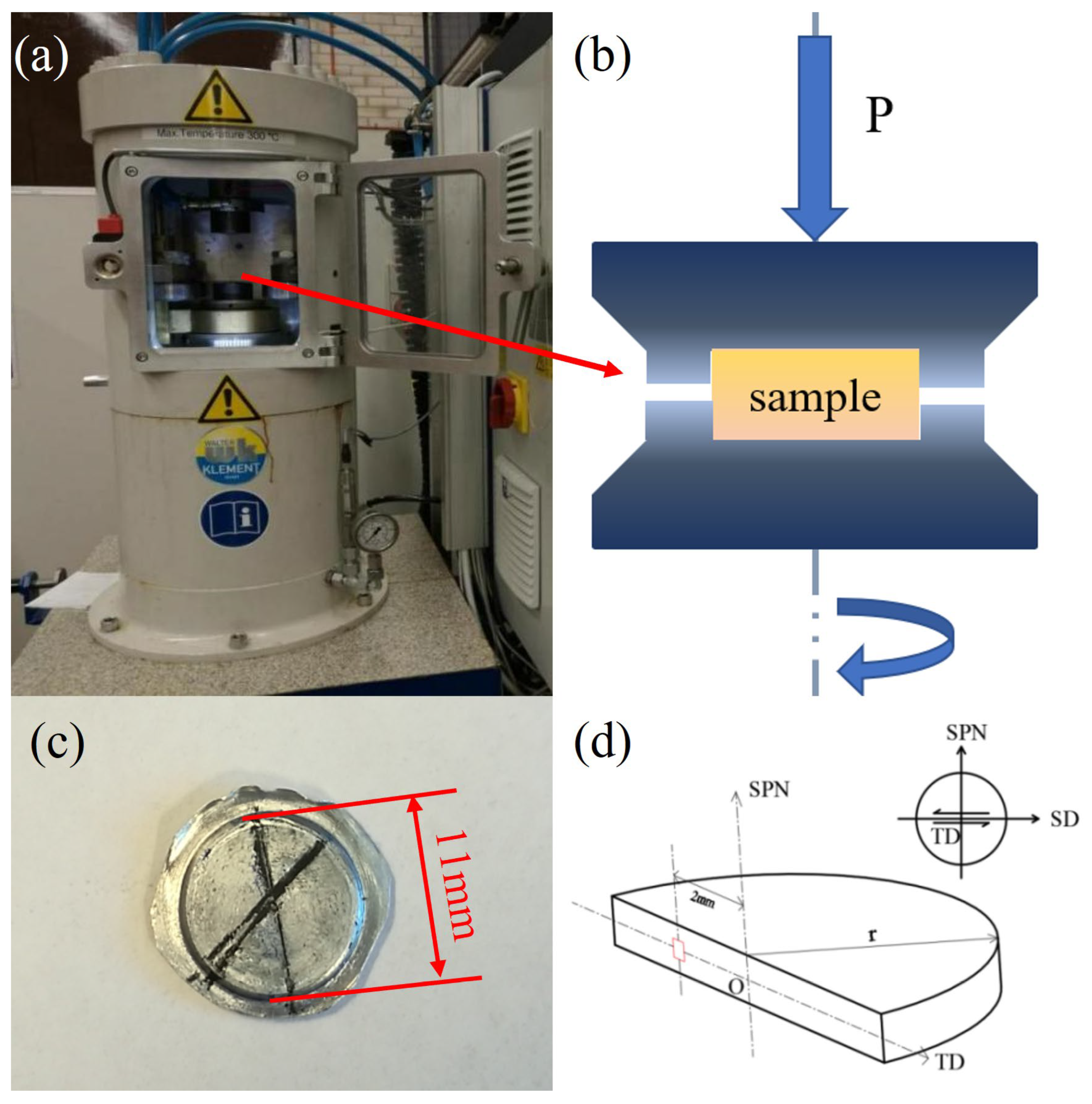
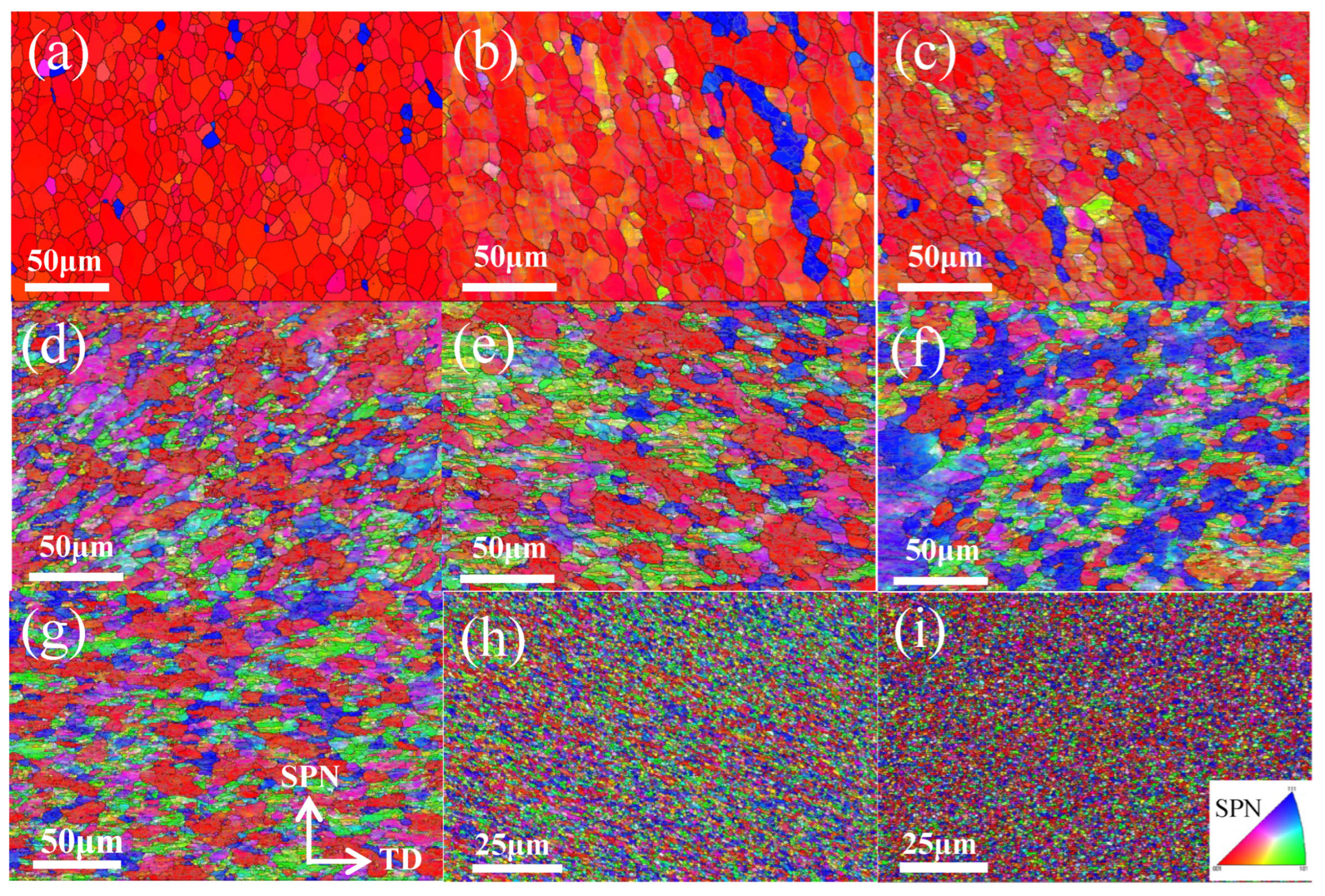

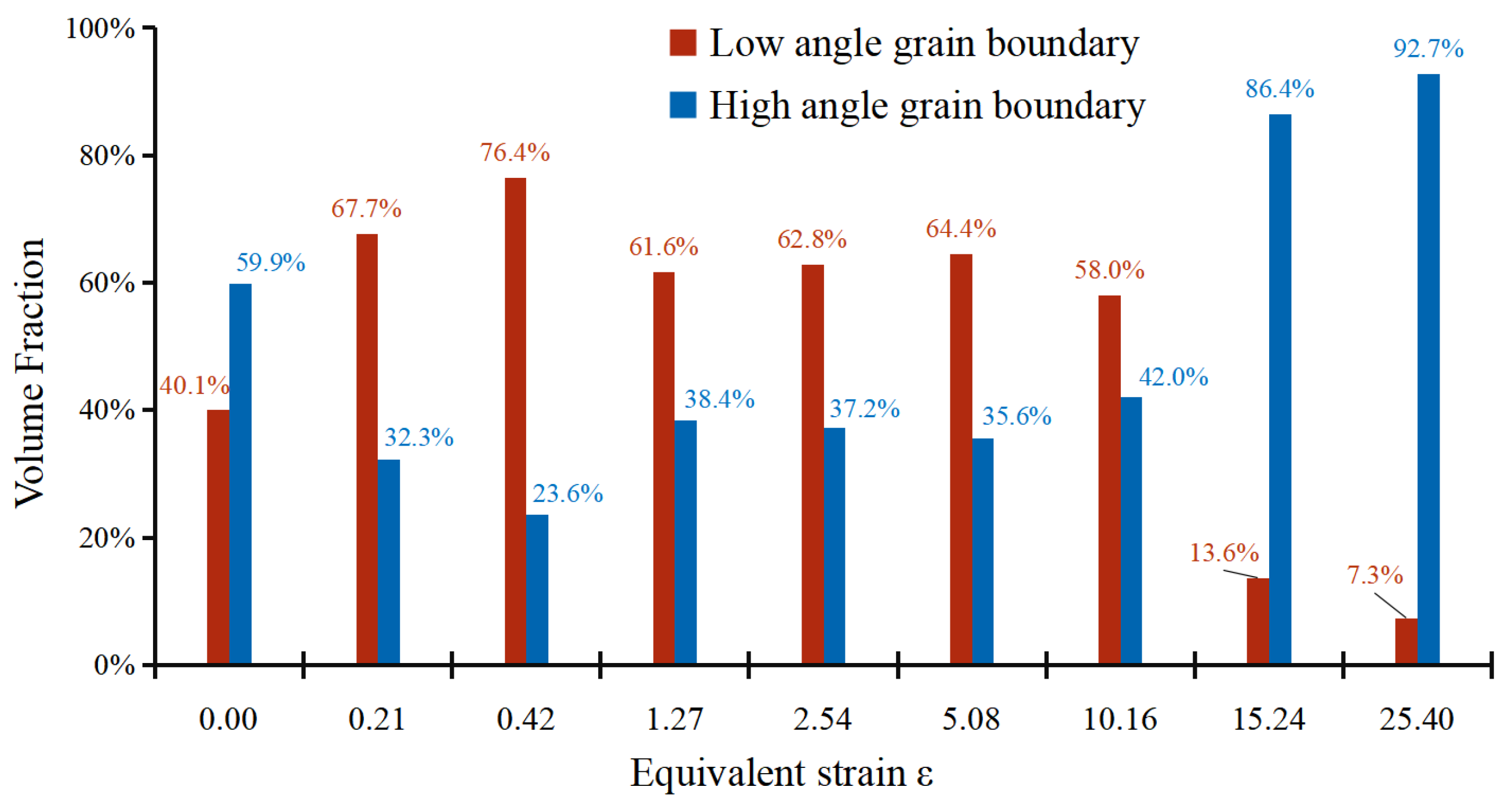
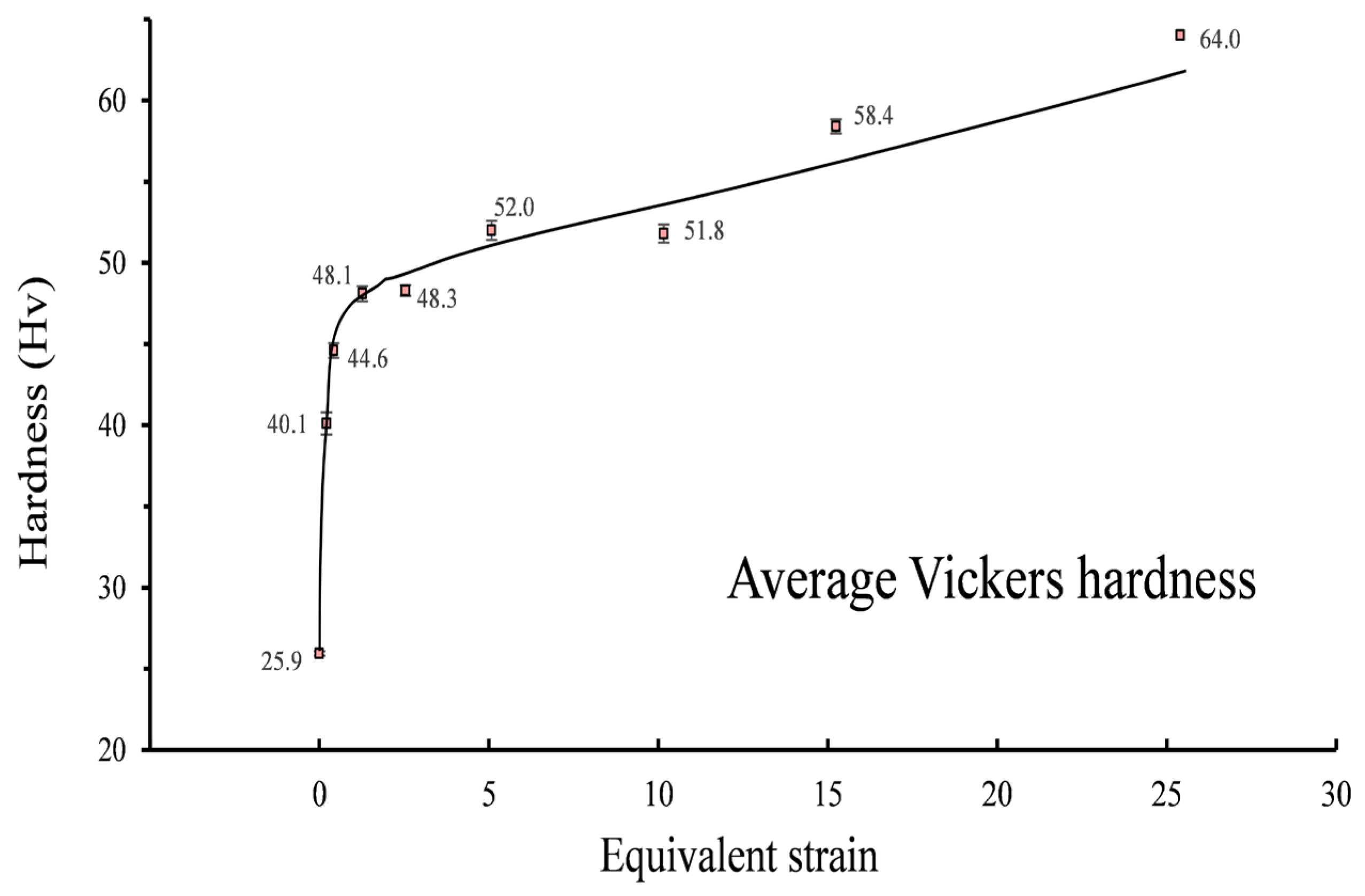
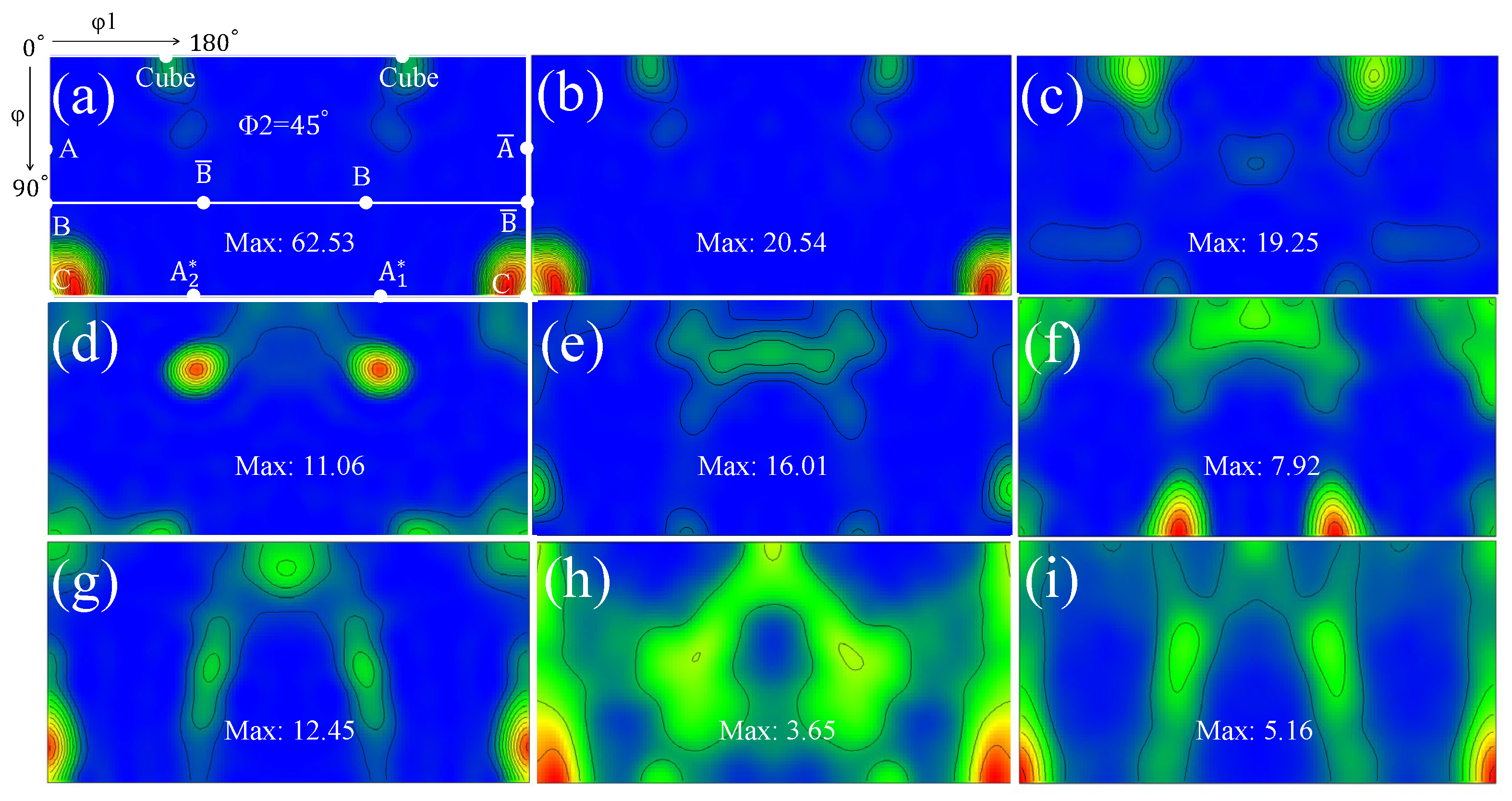
| Rotation angle θ (deg.) | 15 | 30 | 90 | 180 | 360 | 720 | 1080 | 1800 |
| Equivalent strain ε | 0.21 | 0.42 | 1.27 | 2.54 | 5.08 | 10.16 | 15.24 | 25.40 |
Disclaimer/Publisher’s Note: The statements, opinions and data contained in all publications are solely those of the individual author(s) and contributor(s) and not of MDPI and/or the editor(s). MDPI and/or the editor(s) disclaim responsibility for any injury to people or property resulting from any ideas, methods, instructions or products referred to in the content. |
© 2023 by the authors. Licensee MDPI, Basel, Switzerland. This article is an open access article distributed under the terms and conditions of the Creative Commons Attribution (CC BY) license (https://creativecommons.org/licenses/by/4.0/).
Share and Cite
Ni, H.; Ding, C.; Wang, H.; Lv, S.; Wang, X.; Liu, Y. The Evolutions of Microstructure, Texture and Hardness of A1050 Deformed by HPT at the Transition Area. Materials 2023, 16, 4686. https://doi.org/10.3390/ma16134686
Ni H, Ding C, Wang H, Lv S, Wang X, Liu Y. The Evolutions of Microstructure, Texture and Hardness of A1050 Deformed by HPT at the Transition Area. Materials. 2023; 16(13):4686. https://doi.org/10.3390/ma16134686
Chicago/Turabian StyleNi, Hongjun, Chenchen Ding, Haoyu Wang, Shuaishuai Lv, Xingxing Wang, and Yu Liu. 2023. "The Evolutions of Microstructure, Texture and Hardness of A1050 Deformed by HPT at the Transition Area" Materials 16, no. 13: 4686. https://doi.org/10.3390/ma16134686





